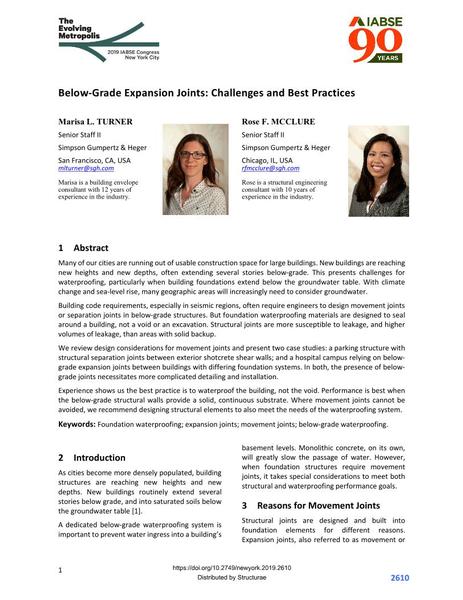Below-Grade Expansion Joints: Challenges and Best Practices

|
|
|||||||||||
Détails bibliographiques
| Auteur(s): |
Marisa L. Turner
(Simpson Gumpertz & Heger)
Rose F. McClure (Simpson Gumpertz & Heger) |
||||
|---|---|---|---|---|---|
| Médium: | papier de conférence | ||||
| Langue(s): | anglais | ||||
| Conférence: | IABSE Congress: The Evolving Metropolis, New York, NY, USA, 4-6 September 2019 | ||||
| Publié dans: | The Evolving Metropolis | ||||
|
|||||
| Page(s): | 2610-2615 | ||||
| Nombre total de pages (du PDF): | 6 | ||||
| DOI: | 10.2749/newyork.2019.2610 | ||||
| Abstrait: |
Many of our cities are running out of usable construction space for large buildings. New buildings are reaching new heights and new depths, often extending several stories below-grade. This presents challenges for waterproofing, particularly when building foundations extend below the groundwater table. With climate change and sea-level rise, many geographic areas will increasingly need to consider groundwater. Building code requirements, especially in seismic regions, often require engineers to design movement joints or separation joints in below-grade structures. But foundation waterproofing materials are designed to seal around a building, not a void or an excavation. Structural joints are more susceptible to leakage, and higher volumes of leakage, than areas with solid backup. We review design considerations for movement joints and present two case studies: a parking structure with structural separation joints between exterior shotcrete shear walls; and a hospital campus relying on below- grade expansion joints between buildings with differing foundation systems. In both, the presence of below- grade joints necessitates more complicated detailing and installation. Experience shows us the best practice is to waterproof the building, not the void. Performance is best when the below-grade structural walls provide a solid, continuous substrate. Where movement joints cannot be avoided, we recommend designing structural elements to also meet the needs of the waterproofing system. |
||||
| Mots-clé: |
joints de chaussées
|
||||
